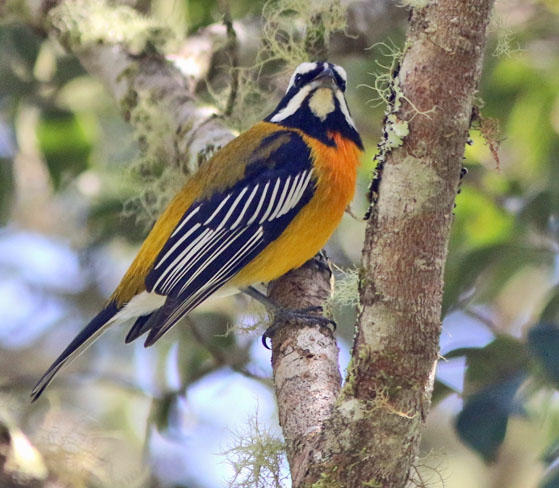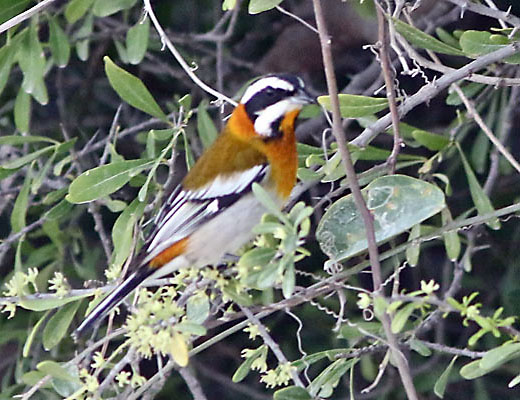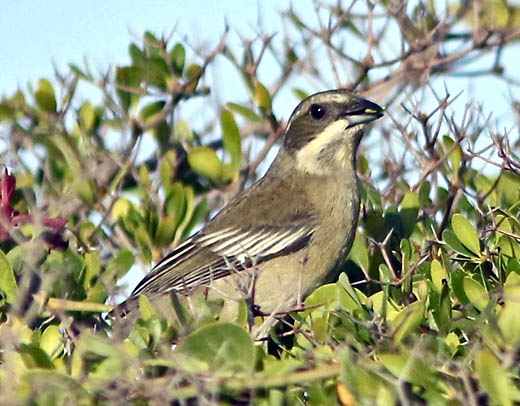| |
SPINDALISES Spindalidae |
- 4 species on Caribbean islands
- DR personal total: 4 species (100%), 3 photo'd
|
 This (left) is the colorful male Jamaican Spindalis. It is one of four species of genus Spindalis — once called "Stripe-headed Tanagers" — that comprise the heart of this newly proposed family Spindalidae. This (left) is the colorful male Jamaican Spindalis. It is one of four species of genus Spindalis — once called "Stripe-headed Tanagers" — that comprise the heart of this newly proposed family Spindalidae.
An
extensive analysis of the relationships of nine-primaried passerines
(tanagers, New World warblers, sparrows, buntings, etc.) by Barker et
al. (2013) found firm evidence of evolutionary sets of "tanagers" that
arose on islands in the Caribbean. Indeed, those authors even went so
far as to propose four new families from this radiation [Spindalidae,
Nesospingidae, Phaenicophilidae, Calyptophilidae]. Initially cautious,
I placed these together in 2014 in just one family. Now, following
Winkler et al. (2015), and AOU and Clements checklists, I adopt all the
proposed families.
Despite the English names we use, these are not
tanager. Yet most of them have been called "tanagers" in the past, and
so we can continue to do so. We just need to recognize that there are
many birds called "tanagers" that are now classified in other families
— to use just one example, Scarlet, Summer, and Western Tanagers,
familiar to North American birders, are actually in the
cardinal/grosbeak family Cardinalidae.
|
The four species of Spindalis in genus Spindalis are Jamaican S. nigricephala, Hispaniolan S. dominicensis, Puerto Rican S. portoricensis, and Western S. zena.
More many decades they were lumped together as one widespread Caribbean
species, and was known as "Stripe-headed Tanager," until split on
morphological and vocal grounds by Garrildo et al. (1997).
Most Spindalises are resident within their namesake islands, generally preferring open forests, gardens, and scrub habitats. Western Spindalis
(right, male above, female below) is more widespread, occurring in the
Bahamas and the Turks and Caicos Islands, on Cozumel Island off the
Yucatan Peninsula of Mexico, on the Cayman Islands, and in Cuba. It is
a rare visitor of extreme southern Florida, but a pair of the Bahamian
subspecies S. z. zena successfully nested in 2009.
All the four members of genus Spindalis
are sexually dimorphic, with colorful males — with much orange and
black — and duller females that wear shades of brown or gray. Western
Spindalis is a dramatic example. Yet, despite the male's bright colors,
they can be hard to spot within foliage, and in my experience the pairs
or small groups seem constantly on the move.
Spindalises
are somewhat omnivorous with reasonably heavy bill, but feed heavily on
fruit or (seasonally) insects. They build cup-like nests. |
|
|
| |
Photos: The male Jamaican Spindalis Spindalis nigricephala was in Blue Mountains NP, Jamaica, in Feb 2017. The male and female Western Spindalis Spindalis zena were both at Faro Paredón Grande, Cuba, on 11 Feb 2017. All photos © Don Roberson; all rights reserved.
Bibliographic note:
There is no "family book" per se. The species in this set have been
previously covered in books on tanagers, such as Isler & Isler
(1987), or the applicable chapter on "tanagers" in the Handbook of the Birds of the World series.
Literature cited:
Barker,
F.K., K.J. Burns, J. Klicka, S.M. Lanyon, and I.J. Lovette. 2013. Going
to extremes: contrasting rates of diversification in a recent radiation
of New World passerine birds. Syst. Biol. 62: 298-320.
Isler,
M. L., and P. R. Isler. 1987. The Tanagers: Natural History,
Distribution, and Identification. Smithsonian Instit. Press,
Washington, D.C.
Garrildo. O.H., K.C. Parkes, G.B. Reynard, A. Kirkcornell, and R. Sutton. 1997. Taxonomy of the Stripe-Headed Tanager, genus Spindalis (Aves:Thraupidae) of the West Indies. Wilson Bull. 109: 561–594.
Winkler,
D.W., S.W. Billerman, and I.J. Lovette. 2015. Birds Families of the
World: A Guide to the Spectacular Diversity of Birds. Lynx Edicions,
Barcelona.
|
|
|

 This (left) is the colorful male Jamaican Spindalis. It is one of four species of genus Spindalis — once called "Stripe-headed Tanagers" — that comprise the heart of this newly proposed family Spindalidae.
This (left) is the colorful male Jamaican Spindalis. It is one of four species of genus Spindalis — once called "Stripe-headed Tanagers" — that comprise the heart of this newly proposed family Spindalidae. 
